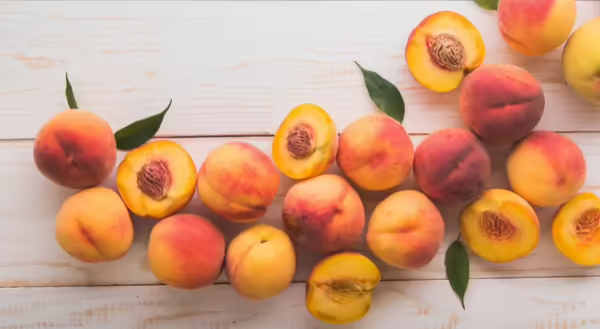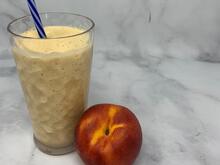
Peaches are one of a handful of foods I don't buy fresh unless it's summertime and I can get them locally. The quality and flavor of peaches in summer from a local farm is just. so. good! My favorite way to eat them is on their own. No muss, no fuss. But there are lots of ways to prepare peaches, with three tasty recipes at the end of this blog post to give you inspiration.
In reviewing resources for this post, I learned something new: "Non-Melting Flesh" and "Melting Flesh." Peach varieties with melting flesh almost dissolve in our mouths as we eat them. They're more commonly sold fresh, since they have a short shelf life. Non-melting varieties stay firm as they ripen and are commonly used in canning, since they hold up to the heat of the canning process. How cool!
Nutritionally, one medium peach contains around 60 calories, 15g carbohydrates, and 2g fiber, and contains vitamins and minerals, including vitamin C, folate, and potassium. Peaches are not a significant source of fat, protein, or sodium.
- Buy: For fresh peaches, look for those that are firm, without broken skin or wrinkled or soft spots. For canned and plastic-packed cups of peaches, buying varieties packed in 100% juice reduces added sugars. Canned "lite" peaches often have alternative sweeteners added, if that is a concern for you. Frozen peaches are commonly sold plain, without added sugar.
- Price: Fresh peaches average $1.68 per pound, according to the U.S. Department of Agriculture. A pound is around 3 medium peaches.
- Store: Fresh peaches are often sold under-ripe. Ripen them at room temperature until the peaches start to smell sweet and are soft when pressed gently. Once ripe, eat them soon, refrigerate to add a few extra days to their storage, or see the Preserve section for tips on longer storage.
- Prepare: Wash fresh peaches under cool water before eating. Remember there is a pit inside each peach. Some peaches twist off their pits easily ("freestone"), while others tend to cling to the pit ("clingstone"). Cut around the pit on clingstone peaches as best you can.
- Preserve: Fresh peaches are quickly perishable, meaning their quality does not last very long once ripe. The National Center for Home Food Preservation has a long list of recipes and instructions for preserving peaches.
- To preserve plain, try canning or freezing. Be aware that white-flesh peaches are not recommended for canning, as they are higher pH (or lower in acid) than yellow-flesh peaches.
- For classic spreads, try Peach Jam, Peach-Orange Marmalade, and Peach-Pineapple Spread (reduced-sugar).
- For something unexpected, try the Peach Apple Salsa.
- Eat: Enjoy peaches raw as a snack, pureed into dishes like smoothies, on salads, and in hot and cold desserts. For peaches that become mealy when ripened, use in a recipe where the texture doesn't matter, like a smoothie or muffin.
Nectarine & Peach Fruit Salad | Print recipe
serves 6
Peach Smoothie | Print recipe
Serves 3
Corn and Peach Salsa | Print recipe
Serves 16
Resources:
-
Ingham, B. University of Wisconsin Extension, Caution against canning white-fleshed peaches and nectarines, 2022
-
Oregon State University Extension Service, FoodHero, Peach Basics, 2016
-
University of Kentucky, Peaches, N/D
-
United States Department of Agriculture, FoodData Central
-
Virginia Cooperative Extension, Eat Smart, Move More, All About Peaches, N/D
-
Washington State SNAP & SNAP-Ed, Fresh from the Farm, Peaches
Melting and Non-Melting References:
-
Brecht, J. Melting & Non-melting Flesh Peaches: Harvesting for Optimum Fruit Quality, University of Florida, 2014.
- McPherson, C & Farcuh, M. Fruit Quality: The Importance of Fruit Textural Characteristics, University of Maryland Extension, 2021.
-
McPherson, C & Farcuh, M. Fruit Texture and the Science Behind It, University of Maryland Extension, 2021
-
Ward, D & Gohil, H. Delayed Harvest and Extended Storage of Gloria Peaches, Rutgers/NJAES Extension, N/D.
Posts combined and originally published in 2017; content updated in 2022.
Healthy Eats and Repeat
How much difference is there between canned and frozen foods? How should you cook venison? When is the best time to buy avocados? Get answers to these questions as well as other tips, tutorials and recipes for common kitchen foods and items with University of Illinois Extension Nutrition & Wellness Educator Caitlin Mellendorf. Build your best life. Trust Extension to help.
Caitlin Mellendorf is an Illinois Extension Nutrition and Wellness Educator serving DeWitt, Macon and Piatt Counties in Central Illinois. She is a Registered Dietitian and her work focuses on helping community members gain the knowledge, skills and tools to live healthier, more nutritious lifestyles. This includes providing programs and answering questions about heart health, diabetes, food safety, food preservation, grocery shopping and cooking. You can reach Caitlin by email at chuth2@illinois.edu or call 217.877.6042.


